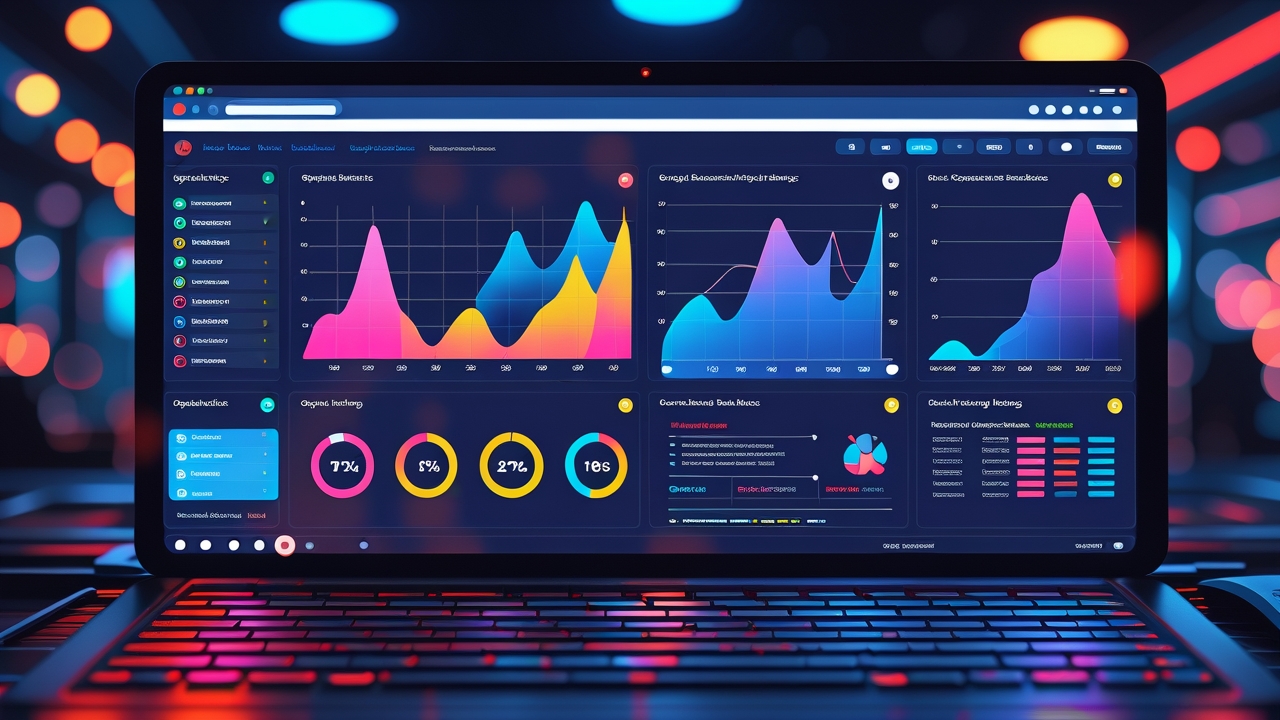Tracking SEO performance requires more than just watching your rankings go up or down. Without proper measurement, you’re flying blind—unable to understand what’s working, what’s failing, or how to optimize your strategy for better results. A systematic approach to SEO tracking gives you the data needed to make informed decisions, prove ROI, and continuously improve your organic search performance.
Table of Contents
Key Takeaways
- Focus on tracking metrics that align with your business goals, not just vanity metrics like keyword rankings
- Use a combination of free tools (Google Analytics, Search Console) and paid platforms for comprehensive SEO measurement
- Establish baselines and track performance over time to identify trends and opportunities
- Regular analysis and reporting turns data into actionable insights that drive strategy adjustments
- Technical metrics like page speed and Core Web Vitals are just as important as traffic and conversion data
Essential SEO Metrics to Monitor
The foundation of effective SEO tracking starts with identifying the right metrics to monitor. Different businesses will prioritize different KPIs, but certain core metrics provide universal value for understanding your organic search performance.
Organic Traffic Analysis
Organic traffic represents visitors who find your site through unpaid search results. Google Analytics provides the most comprehensive view of your organic traffic patterns, showing total sessions, users, and behavioral data. Within the Acquisition reports, you can segment organic traffic to understand which pages drive the most visitors and how that traffic behaves on your site.
Google Search Console offers additional insights into your organic traffic, including impressions (how often your pages appear in search results) and the specific queries driving clicks. This data helps you understand the full funnel from search visibility to actual website visits.
Track these organic traffic indicators:
- Total organic sessions and users month-over-month
- Organic traffic by landing page to identify top performers
- Geographic distribution of organic visitors
- Device breakdown (mobile vs desktop organic traffic)
- Seasonal trends and year-over-year growth patterns
Keyword Ranking Performance
While keyword rankings don’t directly correlate to business results, they provide valuable insights into your search visibility and competitive positioning. Tools like SEMrush, Ahrefs, and SE Ranking offer comprehensive keyword tracking capabilities beyond what Search Console provides.
Rather than obsessing over individual keyword positions, focus on aggregate metrics like the total number of keywords ranking in the top 10, average position across your target keyword set, and share of voice compared to competitors. These broader metrics give you a clearer picture of your overall search visibility trends.
Conversion Tracking and ROI Measurement
Organic conversions represent the business value generated from your SEO efforts. Setting up proper goal tracking in Google Analytics allows you to measure leads, sales, newsletter signups, and other valuable actions taken by organic visitors.
Configure conversion tracking by defining specific goals that align with your business objectives. E-commerce sites should track revenue and transactions, while lead generation businesses might focus on form submissions, phone calls, or content downloads. The key is connecting organic traffic to measurable business outcomes.
Pay attention to both conversion volume and conversion rate for organic traffic. A high conversion rate indicates that your SEO strategy is attracting qualified visitors who match your target audience.
Click-Through Rate and Search Appearance
Your click-through rate (CTR) from search results directly impacts how much traffic you can generate from your current rankings. Google Search Console provides CTR data for both individual pages and specific search queries.
Analyze your CTR performance by comparing your rates to industry benchmarks for different positions. Pages ranking in positions 1-3 should typically see CTRs between 15-35%, while positions 4-10 generally range from 5-15%. Significantly lower CTRs may indicate opportunities to improve your title tags and meta descriptions.
Building Your SEO Tracking Framework
A solid tracking framework provides the structure needed for consistent, meaningful SEO measurement. This framework should integrate multiple data sources and align with your specific business goals and reporting needs.
Start by implementing the core free tools that every SEO tracking system requires. Google Analytics and Google Search Console form the foundation, providing comprehensive data about your organic performance. Ensure proper implementation by verifying that your Analytics tracking code is installed correctly and that Search Console is connected to your verified domain property.
Establish baseline measurements before implementing major SEO changes. Document your current organic traffic levels, keyword rankings, conversion rates, and technical performance metrics. These baselines become crucial reference points for measuring the impact of your optimization efforts.
Develop a consistent tracking schedule that matches your business needs and SEO strategy timeline. Most businesses benefit from weekly monitoring of key metrics, monthly deep-dive analysis, and quarterly strategic reviews. Consistency in your tracking schedule helps identify trends and ensures that performance changes don’t go unnoticed.
Selecting and Integrating SEO Tools
While free tools provide substantial value, paid SEO platforms offer additional capabilities for comprehensive tracking. Choose tools that integrate well with your existing systems and provide the specific data points most relevant to your strategy.
Popular SEO tracking platforms include SEMrush for keyword research and competitive analysis, Ahrefs for backlink monitoring and content gap analysis, and Screaming Frog for technical SEO audits. Many businesses also use specialized tools like PageSpeed Insights for Core Web Vitals monitoring and various rank tracking services for more granular position data.
Analyzing Performance Data for Actionable Insights
Raw data becomes valuable only when analyzed in context and translated into actionable insights. Regular analysis helps identify trends, opportunities, and areas requiring immediate attention.
Look for patterns in your organic traffic data that correspond to your SEO activities. Traffic increases following content publication, technical improvements, or link building campaigns help validate which tactics drive results for your specific site and industry.
Keyword ranking analysis should focus on groups of related terms rather than individual keywords. Group your target keywords by topic clusters or buyer journey stages to better understand how your overall search visibility is improving in strategically important areas.
Monitor your backlink profile growth and quality over time. Tools like Ahrefs and SEMrush track new backlinks, lost links, and changes in your domain authority metrics. Focus on trends in linking domains and the quality of sites linking to you rather than just total link count.
Technical performance metrics like page speed and Core Web Vitals require regular monitoring since they can impact your search rankings and user experience. Google’s PageSpeed Insights and the Core Web Vitals report in Search Console provide the most accurate measurements of how Google evaluates your site’s technical performance.
Transforming Insights into Strategic Actions
The ultimate goal of SEO tracking is driving strategic decisions that improve your organic search performance. This requires translating data insights into specific, prioritized action items that align with your business objectives.
Use performance data to identify your highest-impact optimization opportunities. Pages with high impressions but low CTR present opportunities for title and meta description improvements. Keywords ranking on page 2 (positions 11-20) often represent quick wins that can be moved into page 1 with focused optimization efforts.
Content gap analysis using your SEO analytics can reveal topics and keywords where competitors are capturing traffic that you’re missing. This analysis helps inform your content strategy and ensures you’re creating content that addresses actual search demand.
Regular reporting and communication with stakeholders ensures that SEO insights drive organizational decision-making. Create dashboards that highlight progress toward business goals while providing enough detail for tactical decision-making.
Overcoming Common SEO Tracking Challenges
Most businesses encounter similar challenges when implementing comprehensive SEO tracking systems. Understanding these challenges and their solutions helps ensure long-term tracking success.
Data overload represents one of the most common obstacles. With access to thousands of metrics across multiple platforms, it’s easy to become paralyzed by information without clear action steps. Combat this by focusing on a core set of KPIs that directly relate to your business goals, typically 5-10 key metrics that you monitor consistently.
Attribution challenges arise when customers interact with multiple marketing channels before converting. SEO rarely works in isolation, making it difficult to assign full credit for conversions to organic search efforts. Use assisted conversion reports in Google Analytics to understand how organic search contributes to multi-touch customer journeys.
Technical SEO changes often produce gradual results that are difficult to measure in the short term. Document all technical improvements with dates and expected outcomes, then track relevant metrics over extended periods to identify impact. Core Web Vitals improvements, site architecture changes, and schema implementation typically require 3-6 months to show measurable results.
Maintaining consistent tracking over time requires systematic processes and regular attention. Many businesses start strong with SEO measurement but lose focus over time. Establish automated reporting where possible and assign specific team members responsibility for different aspects of your SEO analytics.
Effective SEO tracking requires balancing comprehensive data collection with focused analysis that drives results. The businesses that succeed with SEO measurement are those that tie their metrics directly to business outcomes, maintain consistent tracking practices, and use their insights to continuously refine their organic search strategies. Your tracking system should evolve alongside your SEO strategy, always serving the ultimate goal of driving qualified organic traffic that converts into business value.




